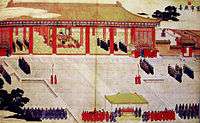Empress Xiaoshengxian
| Empress Xiaoshengxian | |||||
|---|---|---|---|---|---|
 | |||||
| Born | 1 January 1693 | ||||
| Died | 2 March 1777 (aged 84) | ||||
| Spouse | Yongzheng Emperor | ||||
| Issue |
Qianlong Emperor Hongyan, Prince Guo | ||||
| |||||
| House |
Niohuru (by birth) Aisin Gioro (by marriage) | ||||
| Empress Xiaoshengxian | |||||||
| Chinese name | |||||||
|---|---|---|---|---|---|---|---|
| Traditional Chinese | 孝聖憲皇后 | ||||||
| Simplified Chinese | 孝圣宪皇后 | ||||||
| |||||||
| Lady Niuhuru | |||||||
| Traditional Chinese | 鈕祜祿氏 | ||||||
| Simplified Chinese | 钮祜禄氏 | ||||||
| |||||||
| Manchu name | |||||||
| Manchu script | ᡥᡳᠶᠣᠣᡧᡠᠩᡤᠠ ᡝᠨᡩᡠᡵᡳᠩᡤᡝ ᡨᡝᠮᡤᡝᡨᡠᠯᡝᡥᡝ ᡥᡡᠸᠠᠩᡥᡝᠣ | ||||||
| Romanization | hiyoošungga enduringge temgetulehe hūwangheo | ||||||
Empress Xiaoshengxian (Manchu: Hiyoošungga Enduringge Temgetulehe Hūwanghu; 1 January 1693 – 2 March 1777) was a consort of the Yongzheng Emperor of the Qing dynasty. As she was the birth mother of the Yongzheng Emperor's fourth son and successor the Qianlong Emperor, she was posthumously honoured as an Empress.
Life

Empress Xiaoshengxian was born in the Manchu Niohuru clan, which was under the Bordered Yellow Banner.[1] Her personal name is unknown. Her father, Lingzhu (凌柱), served as a fourth class dianyi (典儀; a ceremonial official).
In 1705, Lady Niohuru became a concubine of Yinzhen (Prince Yong), the fourth son of the Kangxi Emperor, and was given the title "gege". In 1711, she bore Prince Yong his fourth son, Hongli and sixth son, Hongyan
In 1722, the Kangxi Emperor died and was succeeded by Prince Yong, who was enthroned as the Yongzheng Emperor. A year later, Lady Niohuru was granted the rank of Consort under the title "Consort Xi" (熹妃). In 1730, she was promoted to "Noble Consort Xi" (熹貴妃). When the Yongzheng Emperor's empress consort, Lady Ulanara, died in 1731, Lady Niohuru was placed in charge of the emperor's harem, making her an acting Empress.
The Yongzheng Emperor died in 1735 and was succeeded by Hongli, who was enthroned as the Qianlong Emperor. As the birth mother of the reigning emperor, Lady Niohuru was honoured as Empress Dowager under the title "Empress Dowager Chongqing" (崇慶皇太后).
The Qianlong Emperor held his mother in high regard and often consulted her for advice. Some believe that she may have been behind the emperor's ill-fated selection of Lady Ulanara to be his second empress consort.[2] The Qianlong Emperor often visited his mother. Empress Dowager Chongqing also always accompanied her son on his excursions to Shenyang and the Yangtze River Delta.[3] In her old age, when Empress Dowager Chongqing was no longer fit to travel, the Qianlong Emperor stopped all his trips and only resumed after her death.
Empress Dowager Chongqing's 60th birthday in 1753 was lavishly celebrated. The Qianlong Emperor ordered the roads decorated from Beijing to the Summer Palace,[4] Chinese poems were read in her honour and sacrifices were made to the gods by the emperor and the entire imperial court. In her honour, the emperor also ordered the dredging of a lake at the Garden of Clear Ripples, which he named Kunming Lake, as well as renovated buildings on the lake shore.[5]
Empress Dowager Chongqing died in 1777 at the age of 84. She was interred in a separate tomb in the Western Qing tombs in Hebei.
See also
Notes
References
- Ho, Chuimei; Bronson, Bennet (2004). Splendors of China's Forbidden City: The Glorious Reign of Emperor Qianlong (Illustrated ed.). Merrell. ISBN 1858942039.
- Rawski, Evelyn S. (1998). The Last Emperors: A Social History of Qing Imperial Institutions (Reprint ed.). University of California Press. ISBN 052092679X.
- Rawski, Evelyn S.; Rawson, Jessica (2006). China: The Three Emperors 1662-1795. Harry N. Abrams. ISBN 1903973694.
- Wan, Yi; Shuqing, Wang; Yanzhen, Lu; Scott, Rosemary E. (1988). Daily Life in the Forbidden City: The Qing Dynasty, 1644-1912 (Illustrated ed.). Viking. ISBN 0670811645.
- Zhao, Erxun (1928). Draft History of Qing (Qing Shi Gao) (in Chinese).
| Chinese royalty | ||
|---|---|---|
| Preceded by Empress Xiaojingxian |
Empress of China Posthumous |
Succeeded by Empress Xiaoxianchun |
| Preceded by Empress Xiaogongren |
Empress Dowager of China 1735–1777 |
Succeeded by Empress Xiaoherui |